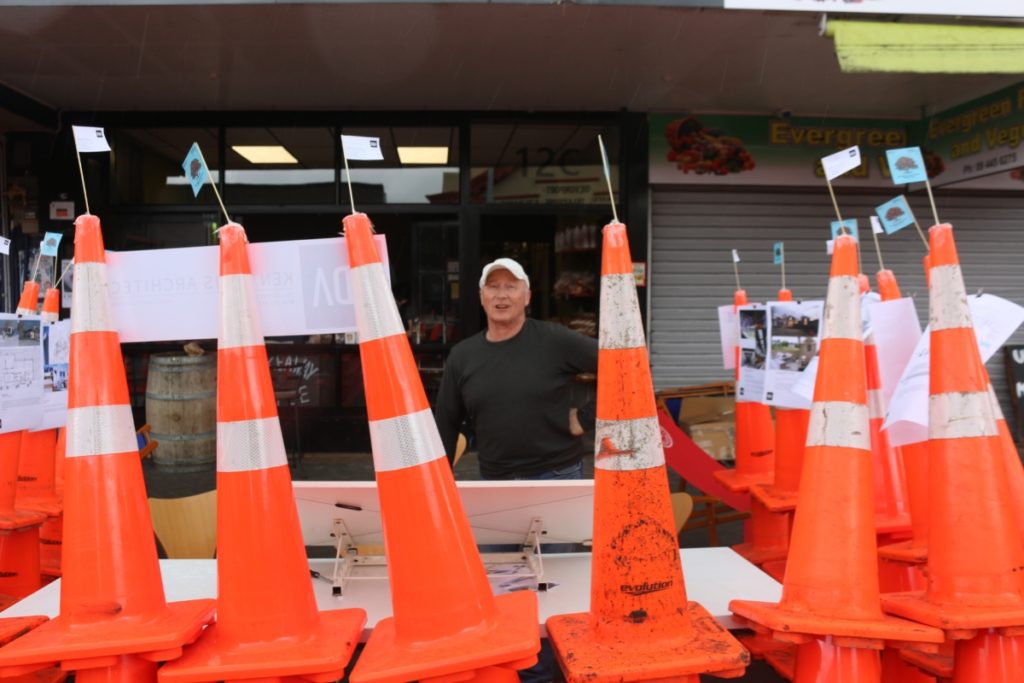What's New
20 May, 2020
Plan targets Clarence St for pedestrian-friendly future
The government is set to spend millions of dollars to make town centres more workable. Local architect Ken Davis spent lockdown drawing up some plans for Devonport. He spoke to Rob Drent.

Imagine music playing on a sun-filled street. You’ve headed down to Devonport village. Friends have ferried over from the city, you grab a bite to eat, run into some other Devonport friends. Good times. Undisturbed by traffic. These are images that have filled architect Ken Davis’s lockdown days.
Devonport Safer Streets Initiative: Covid-19 response – the title of his architectural drawings says it all. He has spent much of the lockdown period working on plans that would make the town safer and more user-friendly. He and a colleague worked from home and swapped drawings remotely.
Reducing vehicle speeds in the village, creating wider footpaths and shutting off a street on a regular basis to create a car-free community hub are the key planks of the Davis plan.
He’s been broadly working on the concepts for years, as an architect interested in urban design. He joined the Devonport Business Association (DBA) in 2012.
He was inspired in 2014 by a speech by former New York Transport Commissioner Janette Sadik Kahn at Auckland Town Hall. She was responsible for a scheme under Mayor Michael Bloomberg that saw cars restricted on some streets in Central Park. It started off as a trial and ended up being adopted permanently. Light bulbs lit up for Davis.
Taking back streets, and giving more priority to pedestrians and cyclists are not new concepts, as towns and cities around the world attempt to make central spaces more attractive and safer for residents and visitors. Why not Devonport?
Davis himself, alongside the DBA, has been involved in a number of relatively low-scale initiatives such as Park(ing) Day (when citizens, artists and designers transform parking spaces into living parks) and a series of events for which Clarence St was closed off to coincide with the Glow light festival.
Initially, Clarence St was closed off on a Saturday, but in recent years it has been the scene of a Friday night ‘After Five’. The events, which featured bands, bean bags, games, food and fun on the street were extremely popular with locals. Many asked why they didn’t happen more often.
Clarence St is ideally placed for the sun: in a southerly blasting up Victoria Rd, punters can be happily sitting at north-facing bars in temperatures 10 degrees higher.
According to Davis, the barrier is primarily cost. Traffic-management plans for the day event cost around $2500, and for the night closure $2000.
Most recently, it has been sponsored by Auckland Transport’s cycling and walking division. Even to run the night event monthly was way beyond the DBA’s budget.
But times appear to be changing. The legislation around the need to have traffic-management plans was introduced decades ago, primarily to protect roadside workers on state highways. Pressure is mounting at council and government level to ease back on the regulations.
The DBA was in talks with the New Zealand Transport Agency (NZTA) late last year to be a pilot area for an improved town-centre project.
While talks had slowed earlier in the year and then stopped under Covid-19, Davis picked up the planning ball again and started running with it during lockdown.
Covid-19 fallout will be around for some time, he says. It will be at least a year to 18 months until a vaccine is found. Under safety-first social-distancing principles, wider pedestrian walkways are needed for people to be 2 metres apart, and also to accommodate customers queuing to get into shops.
Davis wanted to keep things simple by focusing on reducing the vehicle speed limit to 30km/h around the village; and reconfiguring Clarence St so it could become more pedestrian-friendly at all times and offer better spaces if closed off for events.
From a business and tourist viewpoint, “Devonport needs to offer something different to the rest of Auckland, like Takapuna market. There has never been a plan to use Clarence St as a market, – but it has already been shown to be hugely popular with people when it is closed off to traffic,” he says.
Initially, Davis started off with ideas for Clarence St that could be facilitated with the placement of “a few road cones”.
But over lockdown his plans developed into three options:
- Option one is centred on widening the footpaths on both sides to allow better pedestrian movement.
- Option two would see significant widening of the footpath on both sides of the streets, with the removal of parking spots on the southern side.
- Option three would involve the same changes but with the area becoming a shared space for pedestrians and cars, as has been introduced in parts of the Auckland CBD.
Davis hasn’t put Option four on paper, but with a large car park at New World right next door, and further parking nearby in Flagstaff Terrace, Victoria Rd, and outside the ferry building, the removal of car parks altogether would not be out of the question.
While Auckland Council budgets are severely stretched, the government has looked for ways to put money into the economy – with town centres already seen as a focus.
Associate Transport Minister Julie Anne Genter has announced extra funding to help councils expand footpaths and roll out temporary cycleways to help people keep two metres of physical distance after lockdown.
“When people return to city centres following the lockdown, we want them to have enough space to maintain physical distance,” she said. “Some of our footpaths in busy areas are quite narrow. Temporary footpath extensions mean people can give each other a bit more space without stepping out onto the road.”

Funding will come from the Innovating Streets for People pilot fund, part of a wider programme supporting projects that make it safer and easier for people walking and cycling in the city.
While that fund allocated $7 million for such projects prior to coronavirus, the cap has been lifted on what could be spent now, Genter told Stuff. The government is looking at diverting a $100 million-plus NZTA underspend on strategic cycleways into the project.
“Footpath extensions would use basic materials like planter boxes and colourful paint to carve out a bit more space in the street for people walking, like we’ve seen on High St and Federal St in Auckland,” she said.
“A number of cities around the world, including New York and Vancouver, have rolled out temporary bike lanes to provide alternatives to public transport, which people may be less inclined to use in the short term.”
In early May, Auckland Council put forward a first tranche of projects to the NZTA for consideration. More will be submitted in June.
Davis hopes his plans get a favourable airing by the DBA and the Devonport-Takapuna Local Board in the coming weeks.
Auckland Councillor Chris Darby is more direct: “If Devonport doesn’t put its hand up for this money, it will go somewhere else.”
He’s seen Davis’s plans and believes they are just the type of initiative the government is looking for.
Similar changes to streetscapes and pedestrian movement in downtown Auckland have yielded massive results for both residents and businesses in High, Fort and O’Connell Sts. After initial concern about losing car parks near to shops, some have been recording 400 per cent increases in trade, Darby said.
Davis, meanwhile, hopes the community can see the benefits of less traffic on the road and the more people-centric streetscape seen under Covid-19 lockdown.
“Changes are occurring in front of our eyes.”

Please consider supporting The Devonport Flagstaff by clicking here:
